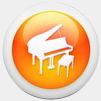
|
|
| HOME LESSONS CHILDREN'S SONGS COMPOSERS |

PIANO LESSONS  CHILDREN'S SONGS 
COMPOSER LESSONS |
Wolfgang Amadeus Mozart—a music appreciation lesson for kidsBiography
 Mozart is wearing a wig in this picture. This was a habit people had in the 1700s. Wolfgang Amadeus Mozart (1756 - 1791) was born and lived in Austria. He was born into a musical family, and from small child, he was immensely interested in music. Starting at the age of six (in 1763), Mozart and his older sister Maria Anna (Nannerl) started playing piano and violin in major cities and in courts to royal families. The family traveled a lot in many European cities. They were so good that the audiences just loved them! Wolfgang also started composing music at a very early age—since age 5! He was very talented both as a composer and as a pianist. He would compose all the time and anywhere, such as when traveling in a wagon, or while eating. As an adult, he earned his living as a composer and as a pianist, sometimes holding a job at some court or city, sometimes just earning money from performing and composing. He married Constance in 1782 at the age of 26. They had six children, but only two of them grew to be adults (the rest died as infants). Mozart died very young, at the age of 35, because he fell seriously ill with something (we do not know for sure what illness it was). He also died a pauper (poor) because he did not handle money very wisely, and he was not always earning lots of it.  Wolfgang-child is playing piano, his dad is playing the violin, and his sister is singing. The style of the music he wrote is called CLASSICAL. "Classical music", as people commonly call it today, comprises different time periods: first the Baroque style music in the 1600s to about 1750, then the Classical style music in the late 1700s to early 1800s, and then the Romantic style music in the late 1800s. So, the type of music Mozart wrote is in the "classical" style. Mozart wrote a LOT of music of all kinds: symphonies (for the whole orchestra), operas, concertos for piano and violin, music for string quartet and string quintet, music for solo piano, etc. He wrote Catholic masses, and also short little pieces like dances and serenades. In all, he wrote over 600 pieces of work. Some of his most famous pieces of music are: Eine Kleine Nachtmusik, Requiem, and his operas The Magic Flute, Don Giovanni, The Marriage of Figaro, and Cosi Fan Tutte. Listen to Mozart's music!As a music appreciation exercise, listen to at least two pieces of Mozart's music using the resources below. When you listen, imagine and try to visualize (see) in your mind what the music is depicting. What can you see when listening to the music? Some animal? Some place? Some feeling? Some kind of weather? For example, maybe some music makes you think of a grasshopper happily hopping along. Maybe the music makes you feel sad, like a child who can't go out to play on a rainy day. Or maybe it reminds you of a hot, busy day when farmers are harvesting their crops. Anything! You can also draw on paper what you see in your mind. Compare your thoughts and feelings with those around you. Eine Kleine Nacthmusic (A Little Night-music or A Little Serenade), from the Valley of the Moon Music Festival. They use instruments just like what were used in 1700s.
This is Mozart's violin sonata nuber 18 in G major (K 301). The piano is accompanying the violin.
This is a little sample from the 2nd act of Mozart's most famous opera, the Magic Flute. Opera is a theatrical act set to music. Instead of talking, people sing, and it has music all through the drama. This one is performed by Antelope Valley College.
Papageno and Pamina Running away from Monostatos. Again, a little sample from The Magic Flute opera, performed by Antelope Valley College.
Here's an interesting video of Mozart's Piano Concerto No. 21, the part called Andante (also nicknamed "Elvira Madigan"). It shows the music score, the pianist's hands, and also a colored chart. The colors indicate which instruments are playing. The reddish colors are the string instruments, the greenish colors are the wind instruments, and thin blue/violet is the piano.
Another, similarly animated score. The piece is Mozart's Piano Quartet in G minor, KV 478, third movement callead Rondeau. The blue is piano score for right hand, the green is piano score for left hand. Yellow, orange, and red are string instruments.
Here's an audio of the Alla Turca (Rondo in Turkish manner), commonly known as the Turkish March. It is one of the best-known piano pieces Mozart composed.
This is Mozart's Symphony no. 40, 1st movement. Conducted by Dima Slobodeniouk — Sinfónica de Galicia.
I hope you liked the song/lesson!I'd also like to introduce you to my favorite: 24K Gold Music - dynamic musical showband performing many genres and styles of music! Check out my monthly GIVEAWAY RAFFLE for 24K Gold Music CDs!
|
